Module 1a: Woodlot Management Planning
 This introductory module is written for anyone who owns woodland or takes an active interest in woodland. This module is an introduction to Woodlot Management Planning
This introductory module is written for anyone who owns woodland or takes an active interest in woodland. This module is an introduction to Woodlot Management Planning
Lesson One - The Importance of Planning
Why is Planning Important?
Suppose that you are travelling in an unfamiliar area. You aren’t sure where you are going or how you will get there. Your surroundings look unfamiliar and you don’t recognize any of the road signs.
That’s what managing a woodlot without a plan is like.
Your woodlot is an incredibly diverse place. It provides habitat for hundreds of species of animals, most of which you can’t see. Most of them are hidden in the soil beneath your feet. There, plant roots share water and nutrients with tiny strands of living fungi. These associations contribute to the health of the forest and are part of what makes a forest a dynamic living community. When humans begin to manage such complex systems, it takes careful planning and a sound knowledge of the science of ecology.
Once you have a plan in place, all the other activities on your woodlot will begin to make sense. You will gain a richer understanding of the ways in which your woodlot can meet your environmental and economic goals, and you will enjoy your woodlot as a place you can go for recreation, spiritual renewal and solitude.
 |
|
| Good planning is the most important step in woodlot management |
As a woodlot owner, you can gain much knowledge by watching what happens on your woodlot over time. If you are able, get out and explore your woodlot. During the course of decades, some tree species will be replaced by others. Ground vegetation may also change, and species of wildlife will come and go. Soils are the most static feature of your woodlot, and a good knowledge of soils can help you understand what happens above the ground on your woodlot.
Neighbouring woodlot owners can be valuable. If they have completed forest management work or built roads, or maintained boundary lines, ask them about it. They can often put you on the right path for contacting people “in the know”, and can also give you a sense of whether they are satisfied with work that has been done.
In this, the first module of the Woodlot Home Study Course, you will learn how planning is the single most important step in meeting your woodlot management objectives, and which elements should be contained in a woodlot management plan.
Valuing Your Woodlot: More than Finances
Why do you own a woodlot, or, if you don’t, why would you want to own one? This question deserves a lot of thought. Rarely do any two woodlot owners share exactly the same long-term desires and objectives.
Some woodlots are inherited, having been passed from one generation to the next over centuries, while others are bought on a whim. The vast majority of woodlots are acquired somewhere in between these two extremes, and it is important to understand the reasons for ownership.
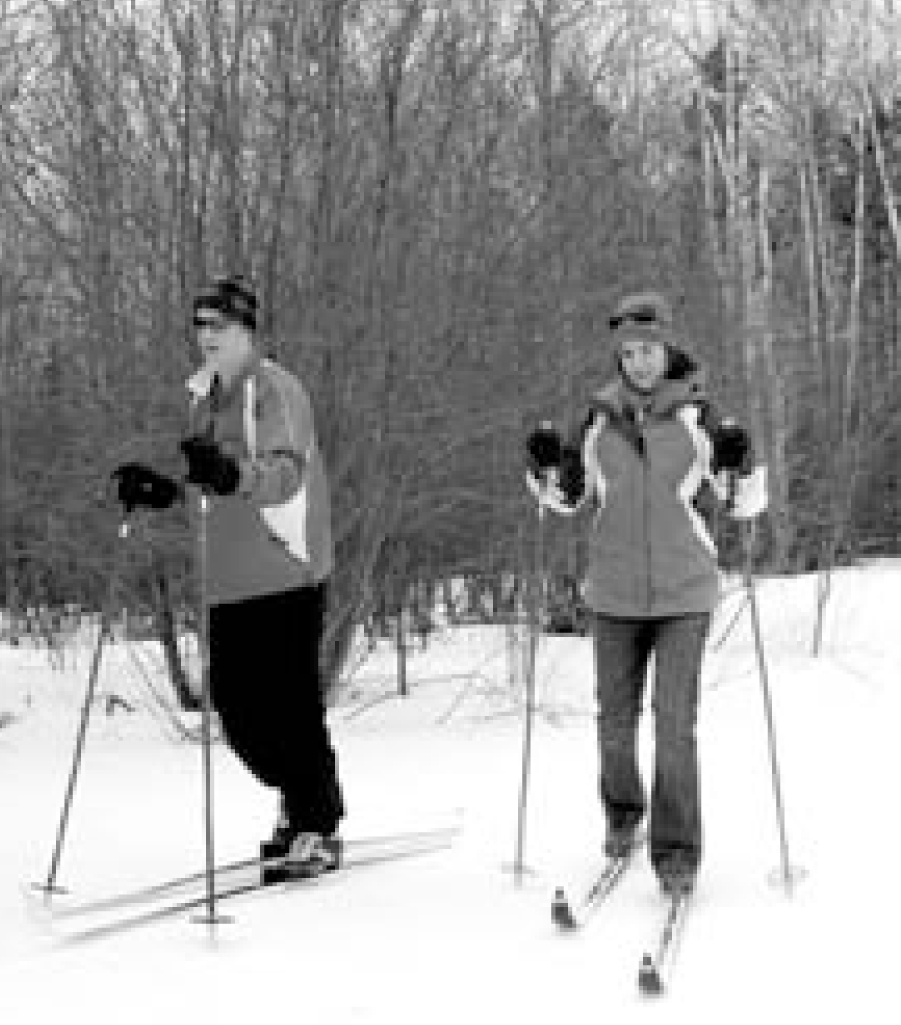 |
|
| Recreation is an essential value for many woodlot owners |
If you own land, you probably have a set of values that you place on your property. For most woodlot owners the value of their woodlot often means more than its economic value. Some landowners place a high value on recreation: their woodlot is a place they can go to walk, observe wildlife, cut fire wood, hunt and fish. Others seek solitude and an escape from the hustle and bustle of a busy life.
Many woodlot owners enjoy the challenges of managing a woodlot for multiple resources. They enjoy getting out for a walk in the woods, away from their workday lives, but would like to see some financial gain from the resources their woodlot holds.
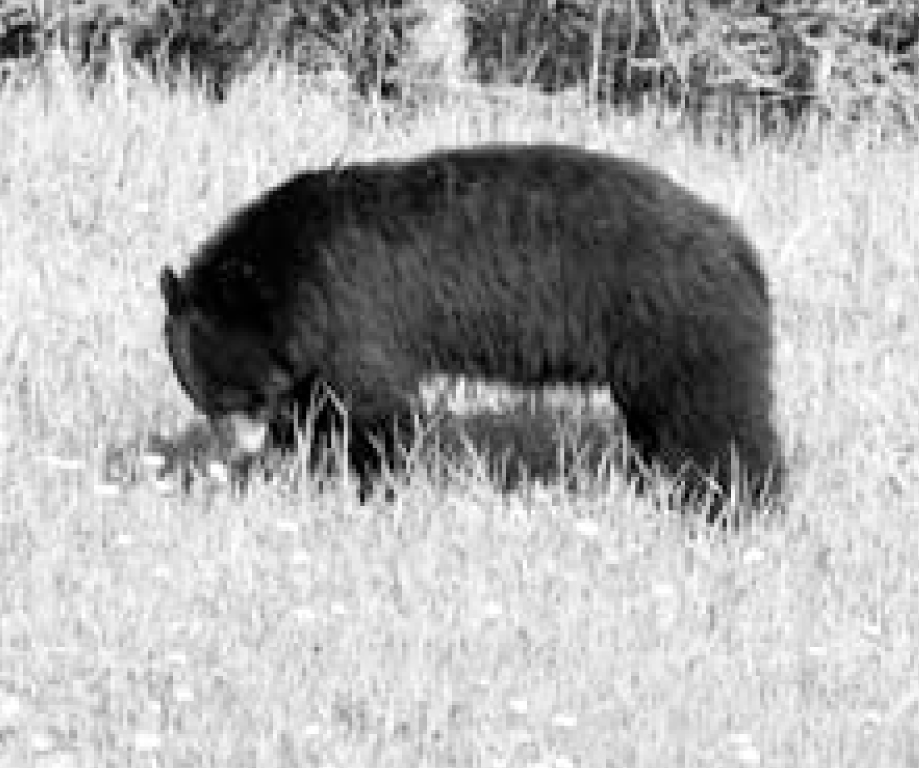 |
|
| Viewing wildlife is important to most woodlot owners |
It can be difficult to meet many objectives all at once. A woodlot is dynamic, constantly changing and full of life and opportunities for the owner. Good planning will help you set objectives and priorities to meet the values important to you.
Module 1a - Lesson One Quiz
| Questions: | 5 |
| Attempts allowed: | Unlimited |
| Available: | Always |
| Pass rate: | 75 % |
| Backwards navigation: | Allowed |
Lesson Two - Setting a Direction: Goals and Objectives
Introduction to Goal Setting
 |
|
| Careful planning will generate income from timber harvesting |
Your goals for woodlot management should directly reflect your values.
Common goals of woodlot owners include:
• Supplementing income by harvesting trees or non-timber forest products
• Managing or holding the woodlot as an investment
• Wildlife viewing and harvesting
• Managing the woodlot to promote healthy ecosystems
• Actively using the woodlot for recreation and healthy living
• Seeking solitude and spirituality
To achieve these goals, an owner must have objectives which, when implemented, should meet the landowner’s long-term goals.
Examples of objectives that meet goals include:
Goal:
• To generate supplemental income while conserving the natural appearance of the forest
Objectives:
• Harvest trees in a manner that preserves the unique structure of the forest
• Harvest enough trees over a five-year period to cover expenses and net a 20-percent profit
Goal:
• To begin to restore the Acadian forest characteristics of the woodlot
Objectives:
• Maintain diversity of the woodlot
• Encourage good quality natural regeneration with small patch cuts
• Fill-plant sites that do not regenerate to shade-tolerant tree species
• Maintain uneven-aged stand conditions
Goal:
• To increase the chances of seeing wildlife
Objectives:
• Retain living and dead trees with cavities
• Build and place wildlife nesting boxes in suitable locations
• Create small openings that will encourage use by whitetail deer and forest birds
Goal:
• To enhance the woodlot for recreation
Objectives:
• Identify and clear trails on suitable terrain for hiking and skiing
• Place sitting benches at several locations
As a woodlot owner you may have several goals, all within reach. Meeting some objectives, however, requires technical skill and “woods-sense”. For this reason you will likely want to consult with a forest professional prior to embarking on an ambitious journey to meet your goals.
Setting out with a good plan is much like stepping off on the right foot. A good plan will give you direction and purpose.
A Look at Your Resources
Most woodlot owners recognize that they have a property with trees and wildlife. There may be streams flowing through the woodlot, old roads and trails, and different tree species may be growing in some areas rather than others. Some woodlot owners make their woodlots a life-long passion, learning about the various trees and ground vegetation, closely observing wildlife and learning their life habits and habitats, and taking courses that teach them how to properly fell a tree.
 |
|
| Many woodlot owners actively manage their properties. |
Other woodlot owners wish to manage their woodlots in a “hands-off” manner. They don’t have the time or ability to learn everything they would like to know about woodlots, or they simply may not be interested.
For both styles of woodlot ownership, it is still important to use all the expertise and information that may be available, including consulting with a forest professional. The planning stages of woodlot management are so critical that you may find that hiring a forest professional is well worth the cost.
Other woodlot owners can be valuable sources of information and enthusiasm. Talking with them can lead you to many excellent resources for your own use. Joining local woodlot owner associations has benefits that are unique and rewarding. Woodlot field days are popular and can bring together landowners with the same interests. Such networking provides good opportunities for woodlot owners to share their knowledge and experiences.
Forest Professionals
Forest professionals have the training and experience necessary for compiling a plan which will consider your goals and objectives and the best ways to meet them. They can help you to set priorities and get work done.
Forest professionals can help you determine the most realistic expectations for your woodlot, based on soils and vegetation types, presence of wildlife habitat, and the growth rates and species of trees. If required, they can estimate the volume and value of wood products, determine the best places for roads, and find boundary lines.
 |
|
| Consulting a forest professinal can help you achieve your goals. |
The cost of hiring a forest professional can vary, depending on your needs. Many forest professionals rely on consulting for their livelihood, so expect to pay for the services you receive. The cost of a detailed management plan can range from several hundred dollars to more than one thousand dollars. There may be additional costs for locating boundary lines, accurately assessing timber values, laying out woodlot roads, and supervising culvert and bridge installation. All of these services cost money, but you need to look at the benefits you will receive.
A relationship between a woodlot owner and forest professional can be lasting and productive. A good management plan is the result of effective collaboration, and once a forest professional becomes familiar with your land, he or she will manage it as carefully as they would their own land, but with your goals and objectives in mind.
Module 1a - Lesson Two Quiz
| Questions: | 5 |
| Attempts allowed: | Unlimited |
| Available: | Always |
| Pass rate: | 75 % |
| Backwards navigation: | Allowed |
Lesson Three - Special Planning Considerations
Most woodlot owners place values on different elements of their woodlots. These values deserve to be looked at in some detail, because they often bind tightly with the physical characteristics of a woodlot.
These values are:
• Healthy forest ecosystems
• Boundary lines
• Wildlife habitat
• Aesthetics
• Spiritual values
• Integrated Resource Management
• Woodlot certification
Forest Ecosystems
Forest ecosystems are communities of plants and animals and their habitats. Every woodlot has forest ecosystems which are dependent on each other, but differ enough from each other that they can be considered separate communities. Identifying and classifying forest ecosystems in Nova Scotia is an initiative that has gained momentum during the last 20 years.
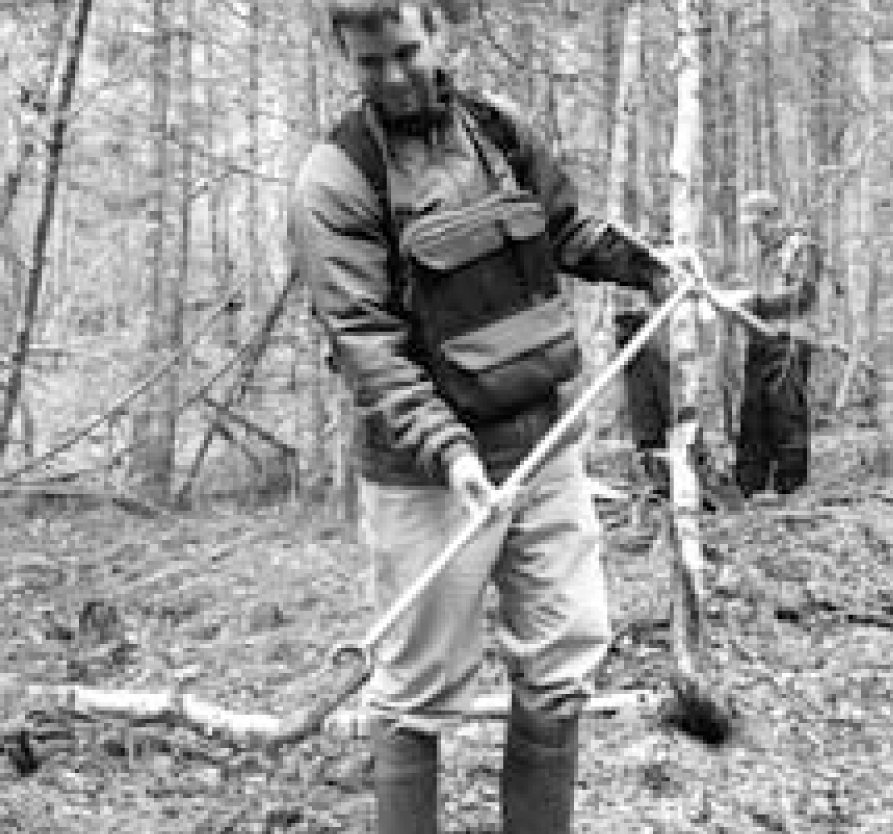 |
|
| Sampling forest soils is an integral part of ecosystem classification. |
Classifying forest ecosystems based on vegetation, soil and site factors has helped forest planners to predict the outcome of forest management practices. By incorporating Forest Ecosystem Classification (FEC) principles into the planning stages of woodlot management, woodlot owners and forest professionals will gain an understanding of the effectiveness and limitations of forest practices on classified sites.
The planning unit associated with woodlot-level FEC is the ecosite. Each ecosite will have unique tree growth and yield characteristics, wildlife habitat components, and biodiversity features.
Some woodlot management plans will have FEC units identified and described in their contents.
This will lead to better informed management planning and predictability as the plan is implemented.
 |
|
| Vegetation type, together with soil type, determines the FEC unit, called the ecosite. |
Many forest professionals are trained in classifying forest ecosystems, and can incorporate this important element into your woodlot management plan.
Good Boundaries Make Good Neighbours
Every woodlot has boundaries which mark the limits of ownership. Some boundaries may have been recently established while others may be centuries old. Where property boundaries intersect they form corners, which are critical points of reference for land surveyors and property owners.
To develop an accurate management plan, the location and condition of boundary lines must be assessed on the ground. Deed descriptions and survey plans can sometimes help locate boundary lines if evidence of the lines can be found. Property Online, a service of Access Nova Scotia, may also be useful in helping to locate your boundaries in relation to other properties or geographic features.
 |
|
| Woodlot boundaries should be well marked. |
Boundary lines should be well maintained, marked and easy to identify. Over time, lines become overgrown with shrubs and clogged with wind thrown trees. It may take a significant effort to locate boundary lines after decades of neglect. In some cases lines must be re-established by a licensed surveyor and if corners are lost, their relocation by a surveyor is essential. It is cheaper to maintain a boundary line than to re-establish one that has been lost!
Boundary lines should be renewed at least once every ten years. This may involve clearing out the brush along the line and re-blazing trees if necessary. Take care not to destroy existing evidence such as old blazes, wire and stone fences, or other indicators of a boundary line. If a tree requires re-blazing, the tree should be marked above or below any existing blaze. Wire can be marked with flagging tape.
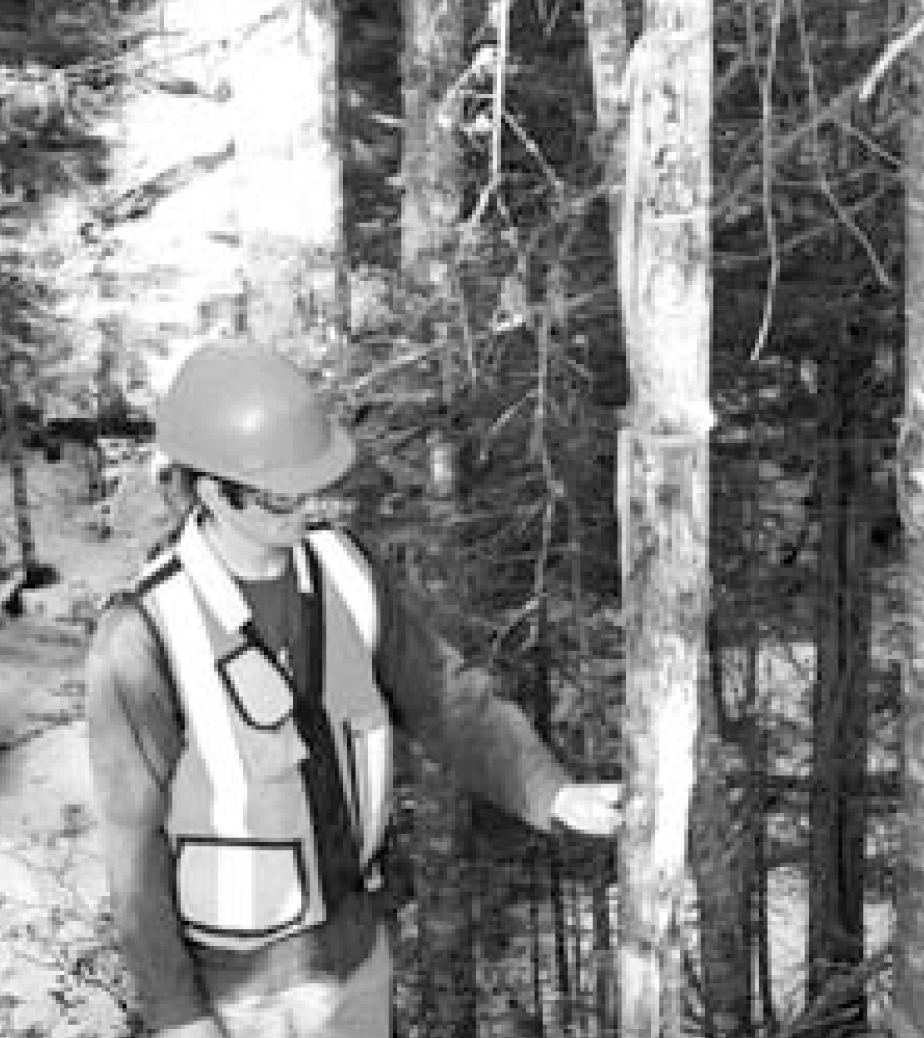 |
|
| Woodlot boundary corners should be clearly identified. |
Property corners are sometimes marked by a metal stake placed by a licensed surveyor, and may have a metal or plastic cap with a reference number. Corners may also be marked with four-sided wooden posts and piles of stone. It is absolutely essential to preserve these corner indicators. If they are encountered in an unexpected location, a licensed surveyor should be consulted to verify any existing evidence.
It can be pleasant work clearing out an existing boundary line. An axe can be used to clear brush and mark trees. Tree blazes should be marked with bright paint, but only when it is certain that they represent the correct boundary.
A woodlot management plan should have a description of the condition of all of the boundary lines, together with any recommendations for maintenance.
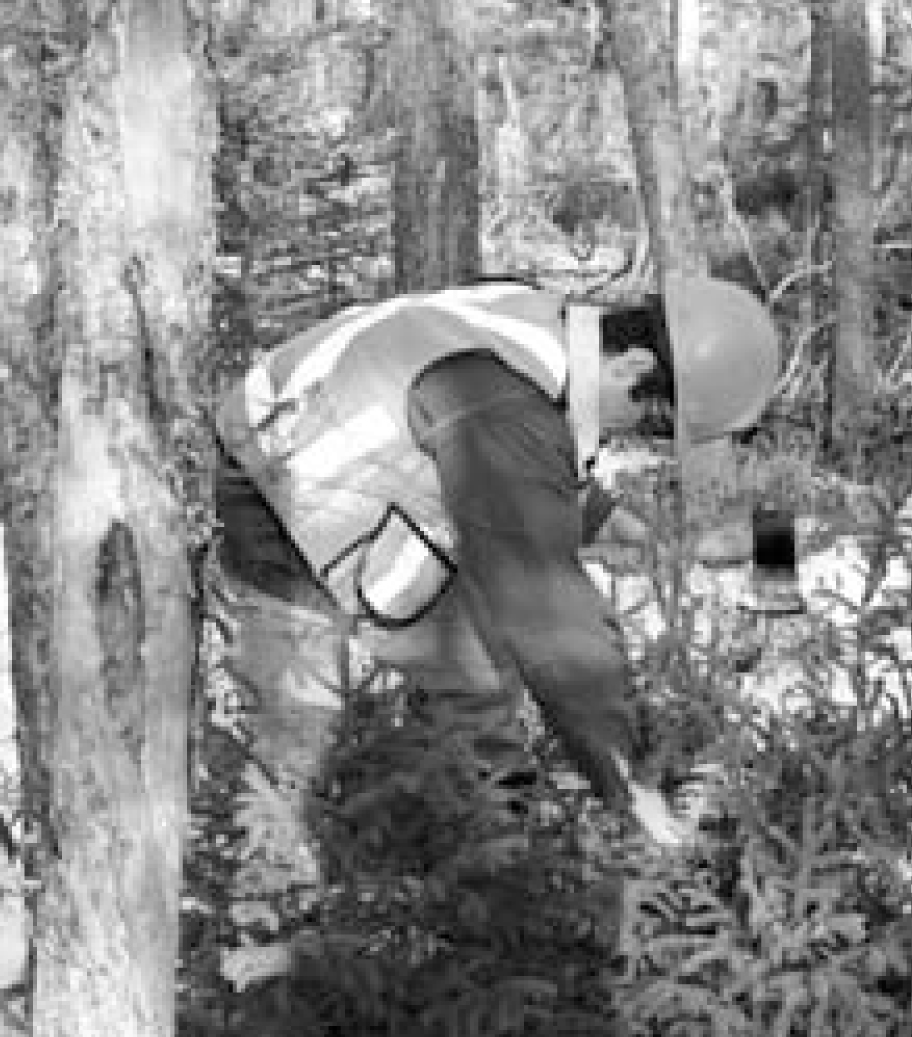 |
|
| Boudary lines must be regularly maintained. |
An accurately established and well maintained boundary brings peace of mind to woodlot owners – on both sides of the line!
A Good Place to Live: Wildlife Habitat on Your Woodlot
Most woodlot owners place wildlife high on their list when asked to identify their interests. A woodlot management plan can indicate areas of a property that already have good habitat or may benefit from habitat enhancement.
 |
|
| Habitat for wildlife can be enhanced on woodlots. |
While Module 4 of this series addresses wildlife habitat, here is a quick summary of important habitat features that may be included in your woodlot management plan:
• Standing dead trees (snags) and living or dead trees with holes (cavity trees) are hotspots for wildlife. These trees are used as perches by raptors such as hawks and owls to look for prey. Cavities made by primary excavators such as woodpeckers may also be valuable as nests and dens for birds and mammals. Where cavity trees and snags are present in your woodlot, they should be identified in the woodlot management plan.
• Apple trees are common on old or existing farm land, and are like magnets to many species of birds and mammals. Where apple trees are healthy but in danger of becoming overgrown by surrounding trees, they can be released and pruned to yield better crops of apples for wildlife. Be sure to mark the presence of apple trees on the woodlot map
 |
|
| Apple trees are like magnets to many species of wildlife. |
• Mast producing trees and shrubs such as oak and beech produce edible seeds that are high in nutrients for many species of wildlife. During the fall and winter, woodlots that contain these tree species are frequently used by whitetail deer, black bears and other mammals and birds.
• Stands of dense softwood are often used as shelter by whitetail deer during winters of heavy snow. These stands should be identified in the woodlot management plan if it appears that they are being used for this purpose.
• Stands of trembling aspen (poplar) make valuable ruffed grouse habitat. The buds and seeds of these trees are eaten by these game birds, while younger stands of aspen provide cover for nesting grouse.
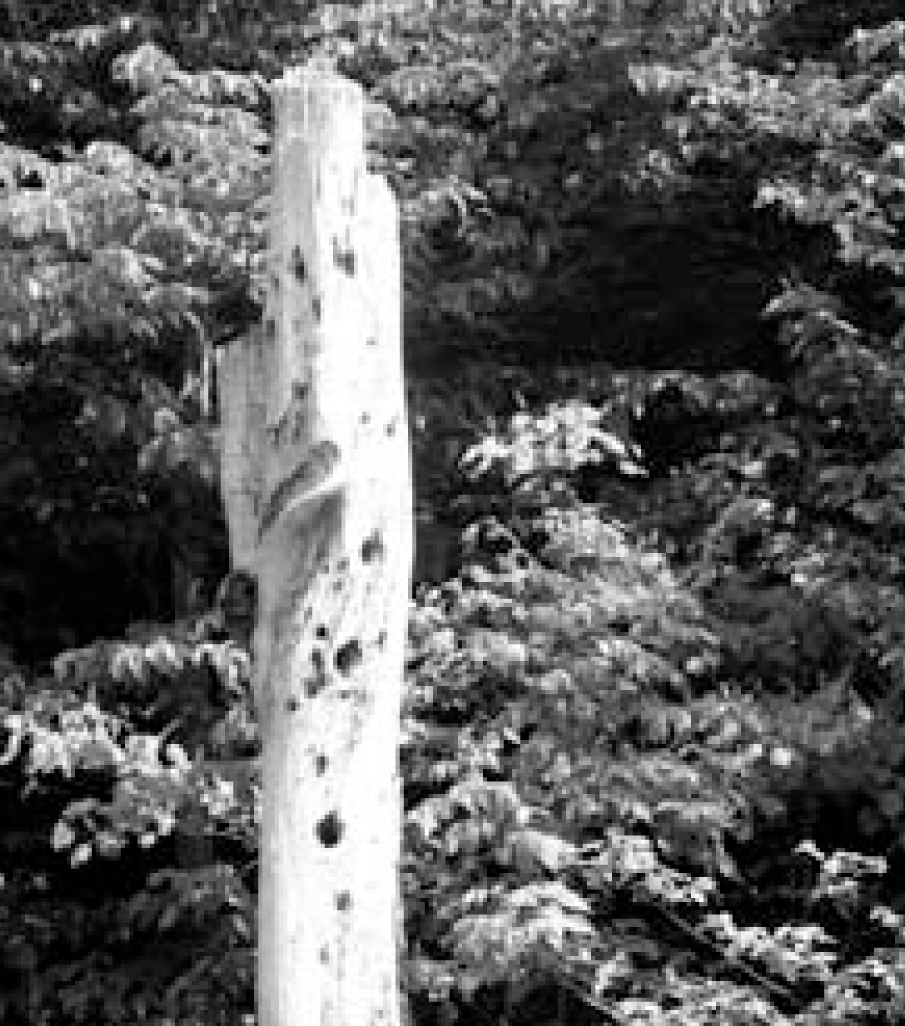 |
|
| Snags are important wildlife features. |
• Alders, which grow on moist soils, provide habitat for woodcock which probe the soft soil for earthworms. Snowshoe hare may also be abundant under the cover of alder thickets. These sites should be identified on the woodlot map as potential wildlife zones.
• Edges of forest stands are frequently visited by many species of forest birds and mammals. Breaks between hardwood and softwood stands are sometimes overlooked as productive wildlife edges.
• Vernal pools are often found in areas where the water table comes close to the surface, or where water has collected on rocky soils. These small bodies of water provide valuable habitat for amphibians such as salamanders and frogs, which are important links in the food chain of a healthy forest. During summer, vernal pools may dry up completely or be reduced to patches of moist soil, and may be overlooked.
 |
|
| Nest boxes help wildlife that nests in cavities. This box provides a nesting site for American kestrels. |
• Watercourses and the areas adjacent to watercourses (called riparian zones) are important travel corridors for wildlife, and provide habitat for species that need to live in or near water. Watercourses must be protected in accordance with provincial regulations, which can be found at www.gov.ns.ca/natr/wildlife/habitats/protection/
Looking Good: Aesthetics and Your Woodlot
Do you prefer a woodlot that has an orderly look about it, with tidy rows of trees and little underbrush? Or would you rather see a diverse, natural looking woodlot that begins to take on the appearance of a primeval forest?
Most woodlot owners take pride in the physical appearance of their woodlots. If you have a preference, this should be considered and noted in your management plan. In many cases, management features such as the size and shape of cutovers, the presence of tree thinning adjacent to roads, and the absence of heavy equipment ruts contribute to a landowner’s goal of good aesthetics.
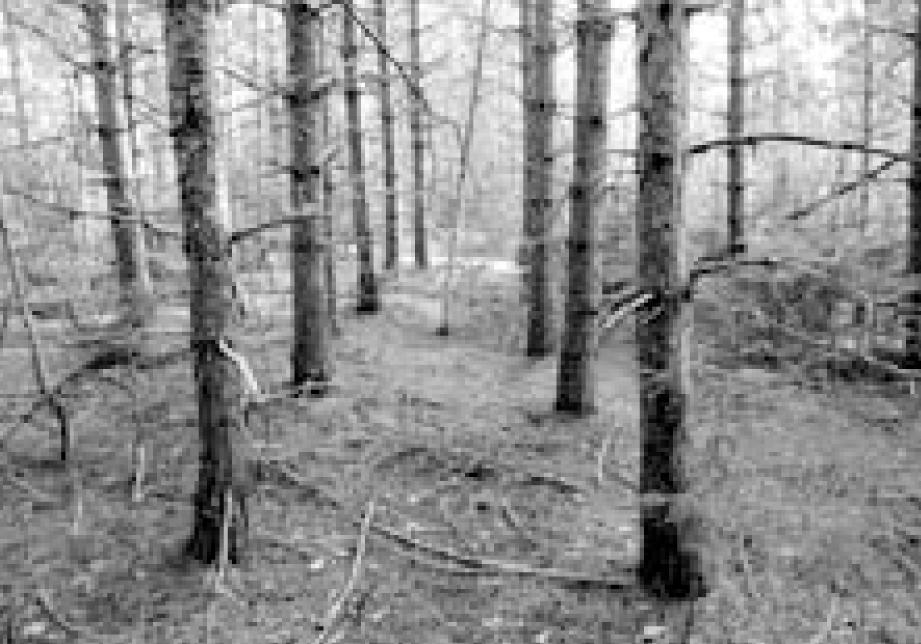 |
|
| Some landowners prefer an orderly-looking woodlot. |
In the Spirit of Things
Many people value the sanctuary and solitude that forests evoke. Woodlot owners often cherish the quiet atmosphere and presence of nature that their woodlots provide, and spend time walking and absorbing the splendor that surrounds them.
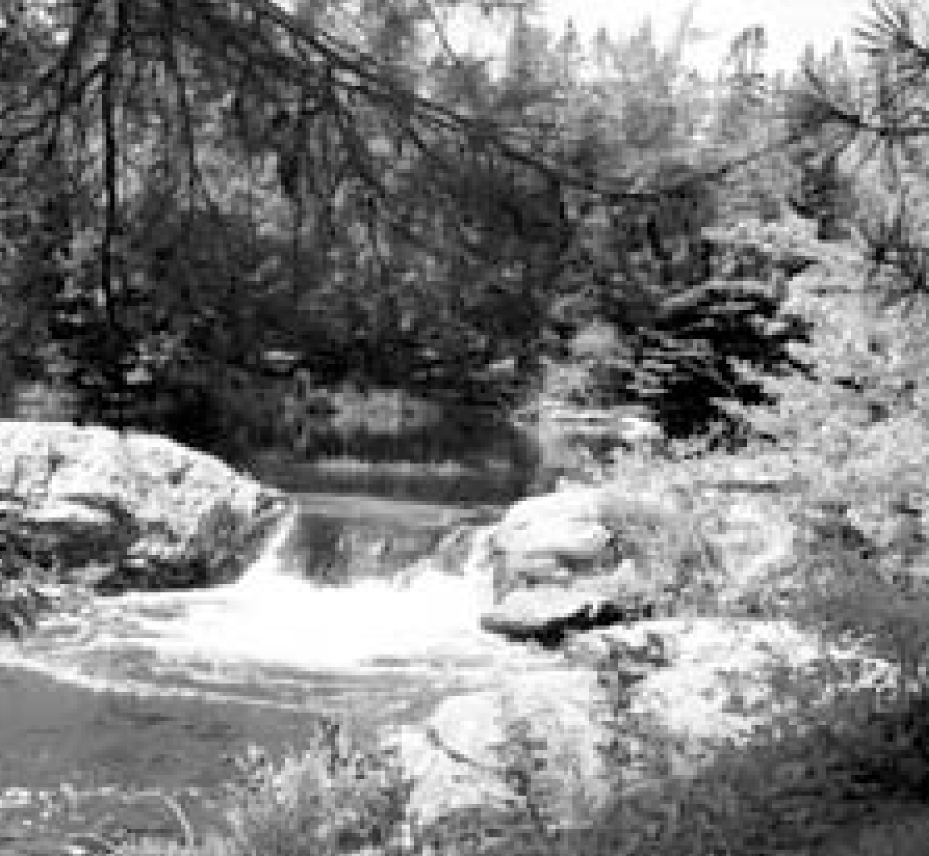 |
|
| Woodlots can be a source of solitude. |
As havens for retreat during vacations and special occasions, woodlots can elicit feelings of escape for their owners. With good planning, work on your woodlot can be scheduled for those times when you may be less inclined to spiritual sanctuary.
Integrated Resource Management
It is important to remember that nothing on your woodlot exists in isolation. Because every living thing on your woodlot is intimately connected, a plan should consider these relationships and link them with your values and objectives.
While timber production may be one of your objectives, the growth of trees is dependent on many things. These can include the moisture content and fertility of soil, the presence of insects and disease, the absence of damaging fires, and various silviculture treatments which can increase tree growth, regeneration and quality.
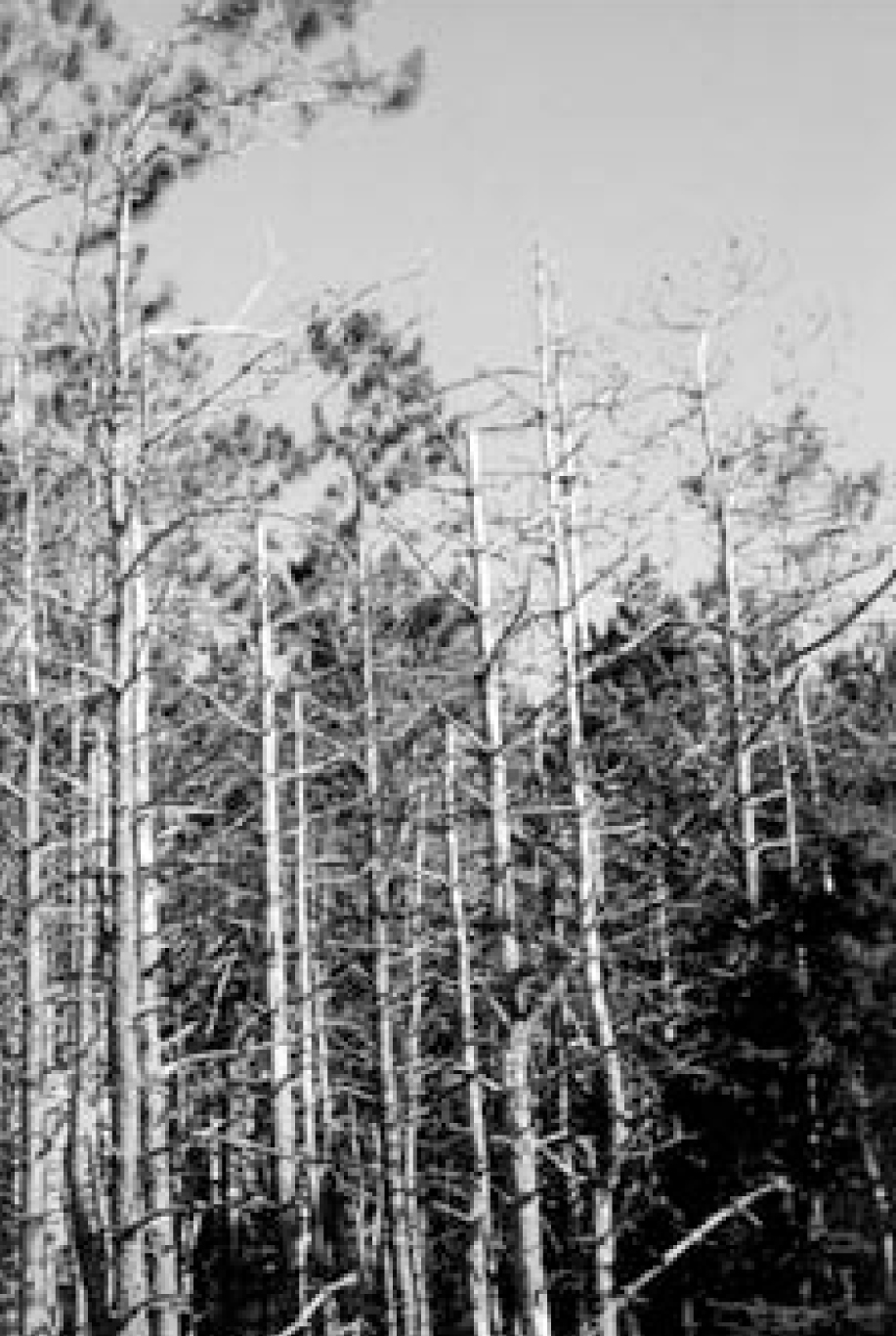 |
|
| Potential insect and disease problems should be addressed in the woodlot plan. |
By managing all of these resources in an integrated and sustainable manner, the overall health of your woodlot will be improved and your objectives will more likely be achieved.
Woodlot Certification
With ever increasing demands for wood fibre, some consumers are choosing to buy forest products from sources that certify that the wood has been produced by sustainable forest practices. These consumers are willing to pay more for their product if it bears the logo of a recognized certification standard.
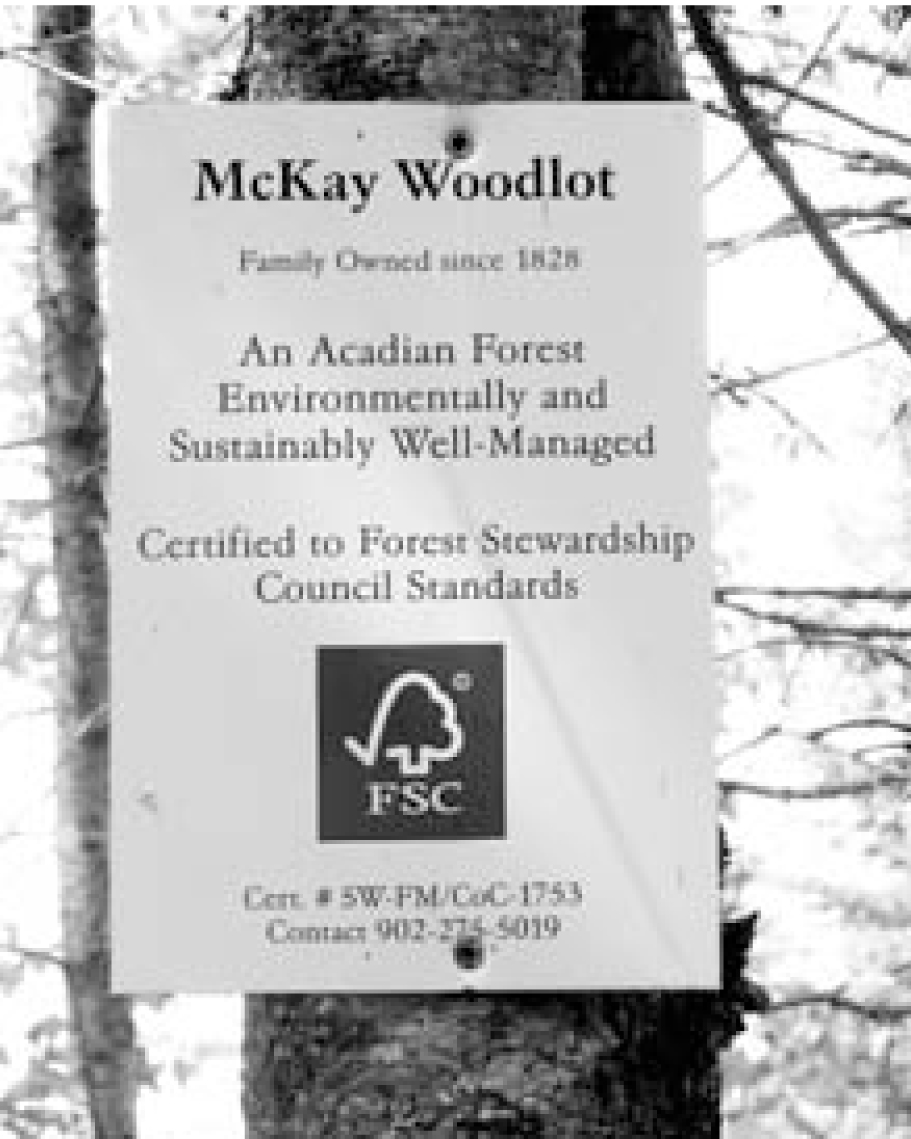 |
|
| Woodlot certification can be a source of pride for woodlot owners. |
Some woodlot owners in Nova Scotia have chosen to have their woodlots third party certified in order to improve access to markets that prefer certified wood products. Each woodlot owner must weigh the costs and benefits of certification to his or her satisfaction.
Woodlot owners in Nova Scotia have a choice of certification standards: Forest Stewardship Council (FSC) or Canadian Standards Association (CSA). It is beyond the scope of this module to explore certification standards, but for planning purposes the standards demand management plans that differ in detail but are similar in scope and design.
Module 1a - Lesson Three Quiz
| Questions: | 5 |
| Attempts allowed: | Unlimited |
| Available: | Always |
| Pass rate: | 75 % |
| Backwards navigation: | Allowed |
Lesson Four - Your Woodlot Management Plan
Collecting Woodlot Data: Tools of the Trade
There are a number of ways that information about your woodlot can be collected. Valuable insight can be gained by looking at maps or aerial photos, while other data must be gathered by walking through the property. This activity is called cruising. A woodlot cruise is not complicated, but by collecting important information about your forest stands, you can gain insight into how your woodlot can be managed.
 |
|
| A woodlot cruise is important in determining your resources. |
During a woodlot cruise, representative sample measurements are taken by using specialized instruments. On a comprehensive cruise, sample measurements of the following are usually taken in each stand:
• Tree species and composition
• Age
• Height
• Diameter
The general growth characteristics and ground conditions of each stand is also noted. In more detailed plans, such as those incorporating Forest Ecosystem Classification, soil types and ground vegetation types are also identified.
Following are some tools and instruments used to gather woodlot data:
AERIAL PHOTOS
Readily available from six Service Nova Scotia and Municipal Relations offices in the province, aerial photos can provide a unique perspective of your woodlot. The location of roads, swamps, cleared areas and other features can be readily identified on aerial photos.
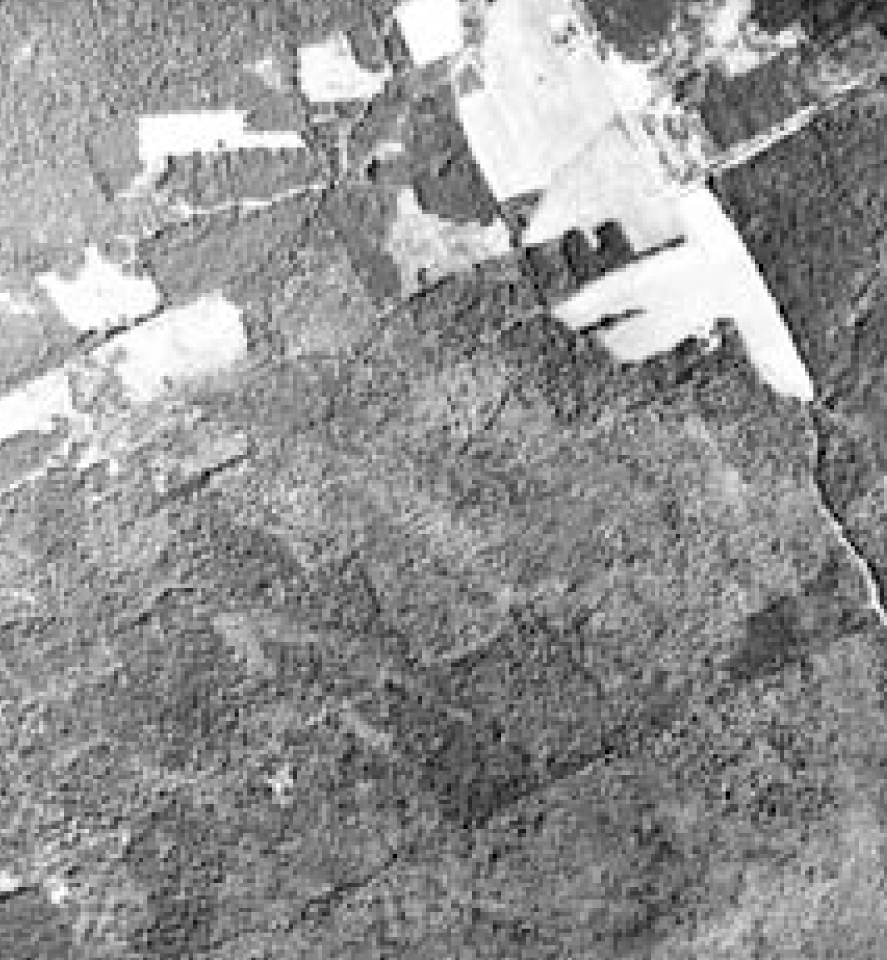 |
|
| An example of an aerial photo. |
New aerial photos of most areas of the province are produced about every ten years. In 2007 the scale of aerial photos was decreased from 1:10,000 to 1:12,500. Some areas of the province are still available only in the earlier 1:10,000 scale photography.
For forestry use, individual trees can be identified on aerial photos, and skilled photo interpreters can identify tree species and the height and volume of forest stands.
Another source of aerial images is Google Earth, which is a free web resource (www.googleearth.com). Although the resolution of Google Earth images is less than that found on provincial aerial photos, the general location of boundary lines, roads, cutovers and other features can often be identified. Google Earth can also give the user a good picture of the surrounding landscape and a “whole earth” perspective.
Aerial photos can save time and walking effort, particularly on large woodlots and when travel is limited by deep snow. As reference tools, aerial photos are integral components of a woodlot management plan.
CLINOMETER
Also called a Suunto or hypsometer, this tool is used to measure tree height. Knowing tree height is essential in determining the volume of a tree or forest stand, and in calculating the land’s capability for growing trees. A clinometer works by measuring the angle between the tip and base of a tree when the user is at a fixed distance from the tree. This instrument can also be used for measuring the slope of the ground, which is essential when planning the locations of woodlot roads.
 |
|
| Clinometer |
INCREMENT BORER
By inserting one end of this hollow tube into a tree and extracting the wooden core, the user can count the cross-sections of the rings and determine the age of a tree. The tree’s rate of growth can also be calculated, and the general health of the tree can be assessed by noting the presence or absence of rot in the core.
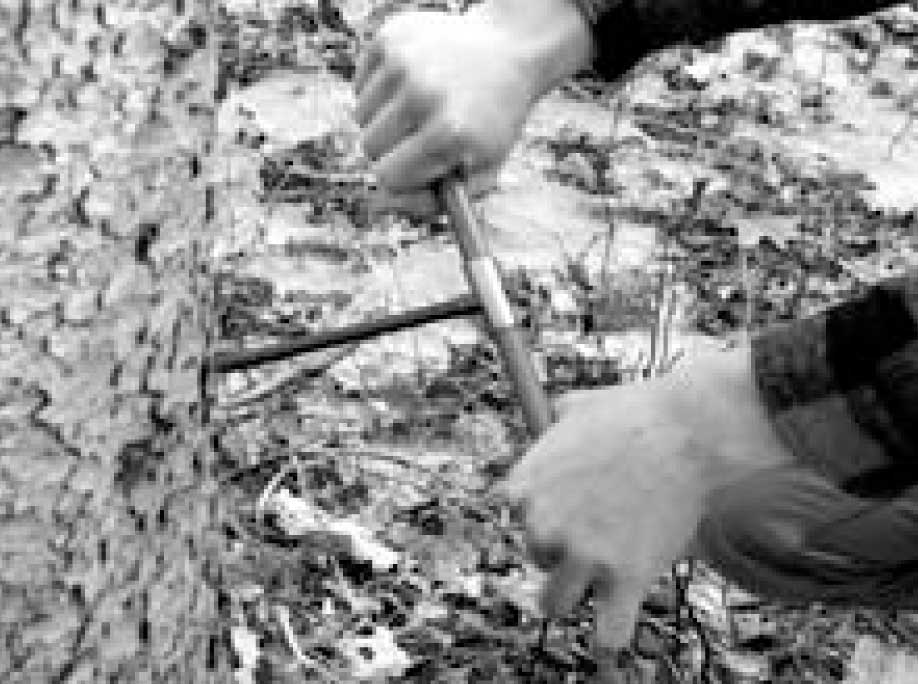 |
|
| Increment Borer |
DIAMETER TAPE
Similar in appearance to a normal measuring tape, a diameter tape is marked in gradations that, when wrapped around a tree, measures a tree’s diameter. Obtaining tree diameter is important in determining tree volume and for marketing purposes such as measuring sawlogs. Usually taken at 1.3 m (4 ft) above ground level, tree diameter can also be obtained with a set of calipers that are designed for measuring trees.
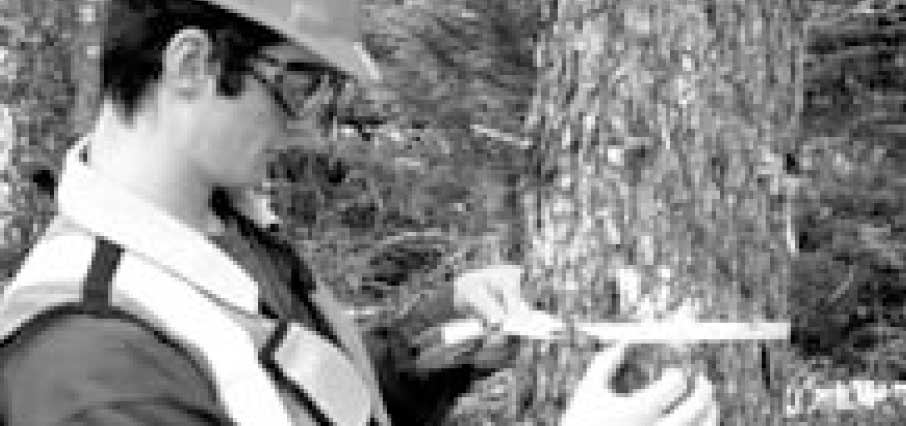 |
|
| Diameter Tape |
GLOBAL POSITIONING SYSTEM (GPS) UNIT
By collecting data on a GPS, the user can easily keep track of his or her location, and can collect the coordinates of individual features such as boundary corners, vernal pools, woodlot roads and trails and other points of interest. Stand areas can also be measured, which greatly assists in job layout and in claiming silviculture funding assistance.
On some models of GPS units, maps can be downloaded to them and the accuracy of boundary lines and other features can be checked. The cost of GPS units can range from a few hundred to several thousand dollars.
Information can be transferred from a GPS unit to a computer for mapping and measuring purposes.
 |
|
| Handheld GPS Unit |
WEDGE PRISM
Constructed of beveled glass, a wedge prism is used to determine the basal area of a stand of trees. The basal area, in turn, can be used to calculate stand volume. Basal area can also be measured with an angle gauge or relascope.
Other tools are used by forest professionals for specialized applications, but the essential instruments are outlined above. Most forest professionals use a map and compass when first visiting a woodlot, and the ability to use these tools remains vital.
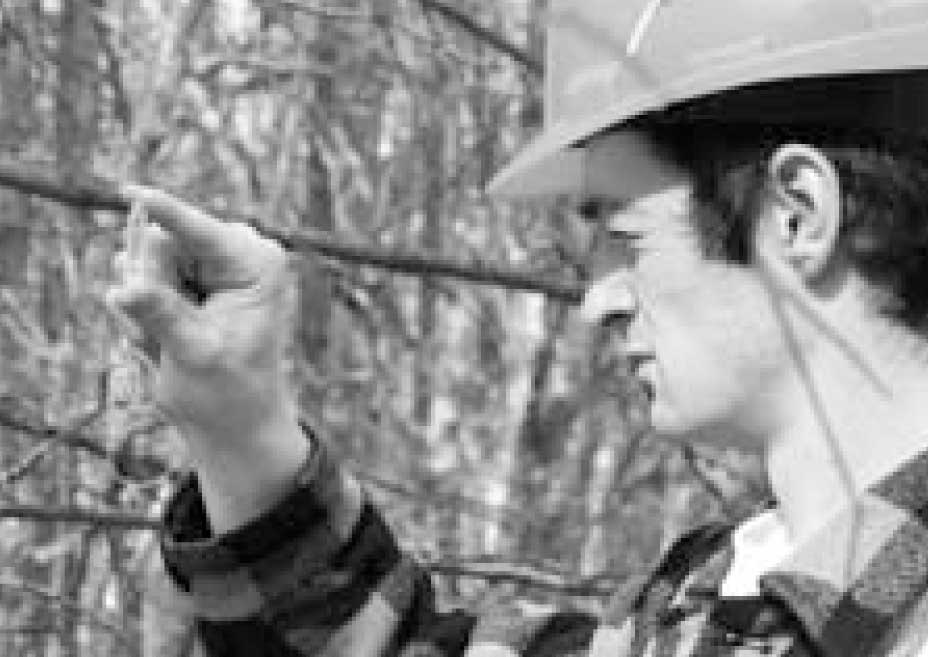 |
|
| Wedge Prism |
Bringing it All Together
Woodlot management plans do not need to be complicated, but they should contain the minimum information that is essential for making decisions based on your goals and objectives. This chapter will outline those components.
WOODLOT OWNER’S GOALS AND OBJECTIVES
These were discussed in Chapter 1, and are in many ways the most important features of a woodlot plan. A woodlot owner’s goals and objectives should be outlined at the beginning of a plan, and the remainder of the plan should make reference to them.
WOODLOT MAP OR AERIAL PHOTO
As a graphic reference, the woodlot map is perhaps the most frequently used tool in a woodlot plan. A well-detailed map will highlight areas of the woodlot that are recommended for treatment, and will indicate the locations of watercourses, roads, and boundary lines.
 |
|
| Example of a woodlot map. |
Woodlot and Stand Descriptions
Woodlot management plans contain descriptions of each stand, which may number from a few to more than a dozen. Stands can vary by tree species composition, average tree age and height, and ground conditions that can vary in moisture content and soil type.
The description of each stand on your woodlot should note the following elements:
• Tree species
• Age
• Height
• Diameter
• Growth rate
• Density and distribution
• Wood volume estimate
• Wood quality
A stand description may also contain notes on wildlife habitat and the presence of any significant features such as relict trees and surface boulders.
A stand is considered even-aged if the majority of trees in the stand are of similar age. If there are at least three age classes, the stand is uneven-aged. The age structure of a stand becomes very important when silviculture options are being considered.
An example of a stand description might be as follows:
SAMPLE STAND DESCRIPTION
Stand 9
STAND TYPE: Red spruce, Yellow birch
AREA: 14.28 ha (35.3 acres)
Dominant species in this stand are Red spruce, Yellow birch, Red maple, and Eastern hemlock. Other species occurring with less abundance are Balsam fir, White birch, and Ironwood. This site was partially harvested about 50 years ago and large residual hemlock trees are found throughout the area, some of which exhibit porcupine damage. These hemlocks average 120 years old. The Red spruce, Yellow birch, and Red maple are in good health and are 60 years of age. Much of the Balsam fir has deteriorated and is no longer merchantable. Patches of 20 year-old Red spruce, hemlock, and fir are distributed unevenly throughout the understory of the stand. Total basal area of the stand is 36 m2/ha.
Stand descriptions are usually summarized in tables that provide the essential information for managing the woodlot. An example of a stand table follows in Table 1:
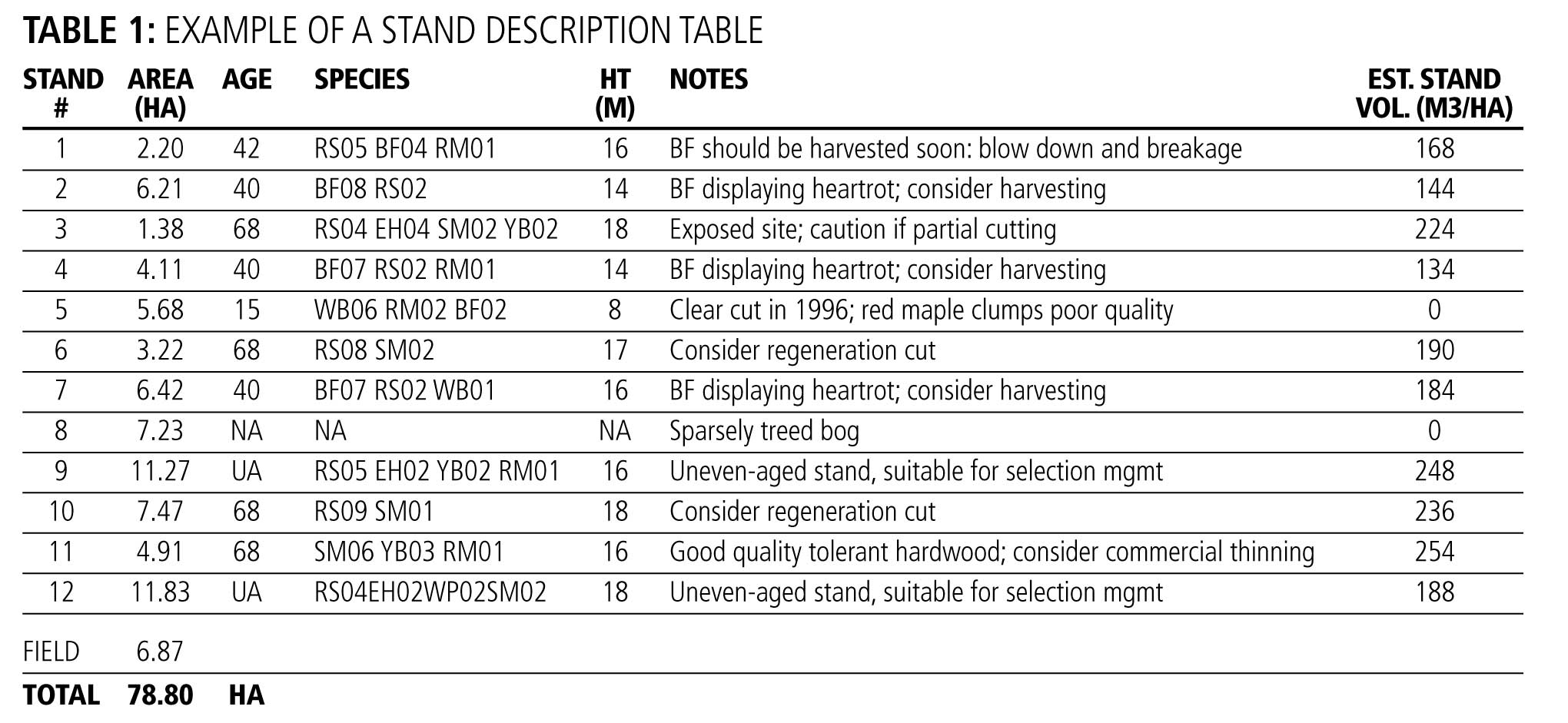 |
UNEVEN-AGED MANAGEMENT
A woodlot owner can choose to manage a woodlot on an uneven-aged basis. An uneven-aged stand can yield volumes of wood at fairly short intervals (10-15 years) in perpetuity. Careful management will maintain continuous tree cover.
There are many considerations when planning uneven-aged woodlot management. It is not suited to all locations: exposure to wind and the presence of imperfectly drained soils increases the risk of blow down to uneven-aged stands. Your forest professional will be able to give advice on whether this management option is right for your woodlot.
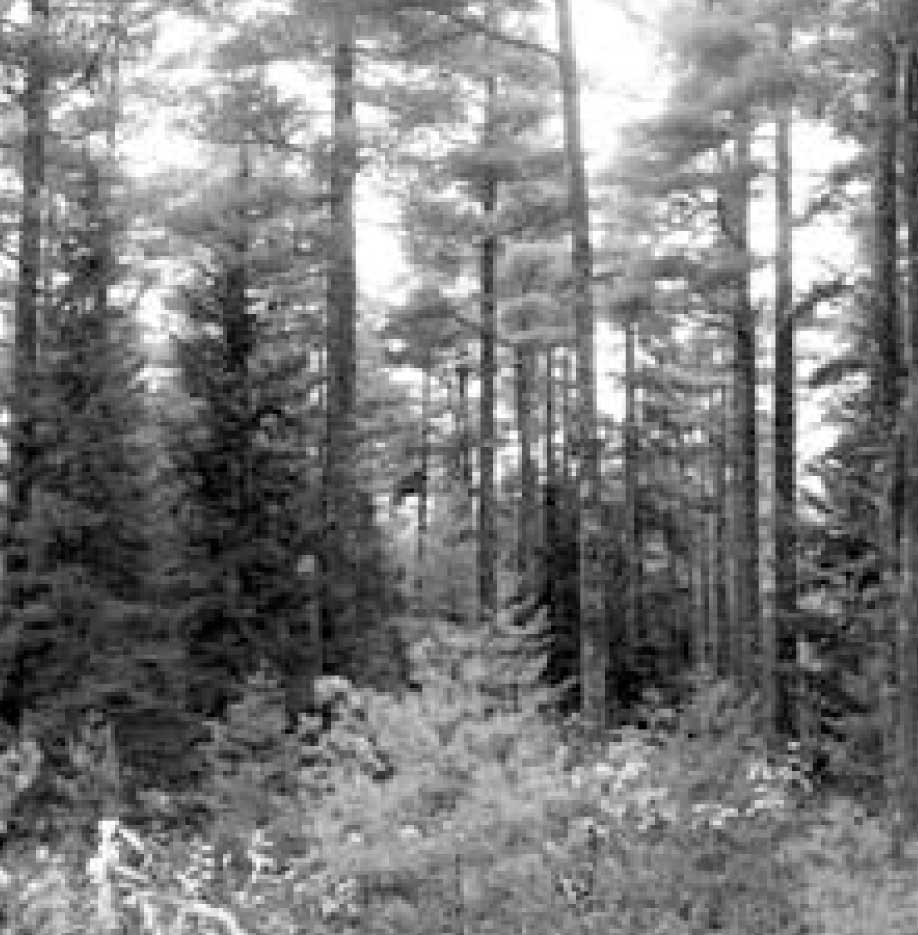 |
|
| Uneven-aged Stand |
Stand Treatment Recommendations
It is important to remember that recommendations for your woodlot are only just that – recommendations. A forest professional collects the information that he or she needs to make reasonable recommendations of treatments that will enhance your woodlot to meet your objectives – whether it is for fiber production, wildlife habitat, human sanctuary or all of these.
Forest professionals have an intimate knowledge of tree silvics, which are characteristics that define each tree species’ life history and growth patterns, including site preference, reproduction and physical form.
A sample of a stand treatment recommendation follows:
SAMPLE STAND RECOMMENDATION
Stand 9
The uneven-aged structure of this stand indicates that it may be suitable for selection management within the next five years. The objective would be reduce the basal area of the stand from 36 m2/ha to 25 m2/ha or less, by removing some trees from each age class. If appropriate markets exist, the poorest quality trees should be removed during this first entry, taking care to avoid creating large openings in the tree canopy. The removal of some of the largest hemlocks will create openings which should regenerate to Red spruce, hemlock and Yellow birch.
Wood removal could be carried out during any season except spring, when sap flow may cause softwood and hardwood bark to become easily damaged. A small to medium-size harvesting processor and a medium-size forwarder could be used to complete this job. Because of the uneven ground, care should be used in selecting wood extraction trails. These trails could be used again during the second entry 15 years later.
Patches of good quality regeneration greater than 2 m (6 ft) in height should be spaced to at least 2 m (6 ft) between stems. Hardwood regeneration should be more than 6 m (20 ft) in height before thinning. This will provide opportunity for the young trees to expand their crowns and increase growth.
Silviculture funding assistance is currently available to facilitate the completion of this treatment.
 |
|
| Partial harvesting helps to maintain uneven-aged stands. |
Roads and Watercourse Crossings
Roads are an integral part of good woodlot management, and every plan should have a well-described outline of access routes. Constructing or upgrading forest access roads can be expensive, but it can also be money well spent. Any harvesting activity will need areas to pile wood where logging trucks can reach it.
Strict regulations govern the installation of culverts and bridges on forest roads. Even temporary structures require permits that ensure the proper construction and documentation of watercourse crossings. All watercourses should be marked on your woodlot map, and where there are crossings, properly sized culverts or bridges should be indicated.
 |
|
| Woodlot management plans bring everything together for the landowner. |
The Management Plan Summary: Bringing it All Together
This section of the management plan should demonstrate how the plan accomplishes meeting your objectives. If, for instance, you are interested in maintaining an uneven-aged management approach to your woodlot, the summary should describe how this may be possible.
The summary should also recommend that the management plan be updated in five to ten years, depending on the degree and types of activities, and the goals of the woodlot owner. If you have long-range goals that may take 30 to 40 years to realize (a relatively short time in woodlot management!), regular updates to your plan are essential. If you are able to consult with the same forest professional over time, your management objectives will probably be more consistent.
Finally, do not be intimidated by the magnitude of your management plan. Forests are complex places, with diverse ecosystems, seasonal moods and special wildlife needs. The care with which your management plan is written will be reflected in your woodlot’s health, vitality, and in your enthusiasm to manage it well.
 |
|
| Good planning leads to good decision-making and appropriate woodlot activities. |
Record Keeping
Over time, activities associated with your woodlot will begin to resemble the transactions of a small business. There may be revenue generated that will require tracking for income tax purposes, along with costs (including the management plan) that could serve as deductions. Like a business, your woodlot activities need a plan, similar to a business plan. Careful balancing will ensure that your goals – financial, environmental and personal – are met.
Next Steps: Following Through with Your Plan
A plan is only as good as the activity it promotes. If a woodlot management plan is difficult or impossible to implement, the expense and time that has been put into it will have been wasted.
Good plans are practical and energizing. A well-constructed and progressive management plan should galvanize the woodlot owner to follow through with stand treatment recommendations and any other activities. There may be permits to obtain before crossing watercourses, and some wetlands may require special approaches or may need to be avoided entirely.
Think of your woodlot as the special place that it is. Think of the millions of animals that live in the soil, the wildlife that depend upon your careful treatment of their habitat, and the water resources that need to be protected. Think of the opportunities that your woodlot presents for your family, your descendants, and the rest of society. Finally, think of the responsibility that you have in owning and managing a woodlot.
You can adequately manage your woodlot through careful and appropriate activities. But the care with which your management plan is written will be reflected in your woodlot’s health, vitality and in your enthusiasm to manage it well.
Module 1a - Lesson Four Quiz
| Questions: | 5 |
| Attempts allowed: | Unlimited |
| Available: | Always |
| Pass rate: | 75 % |
| Backwards navigation: | Allowed |
Planning for the Old Home Place: A Case Study
The Pelly family owns a 160-acre (64.8 ha) woodlot in Antigonish County. They visit the woodlot four or five times a year, mostly for recreational purposes. A small cabin provides a comfortable haven when they make the journey from their home in Halifax. Peter and his spouse Ellen enjoy the solitude that the old farm property provides.
As a direct descendent of an Acadian family that settled in this area in the 1790s, Peter has a strong interest in his heritage. Ellen is also of Acadian descent. Their daughter Ann-Eve has indicated that someday she would like to live on the old home place.
The Pellys are a busy family. Peter and Ellen both work full-time in the city and Ann-Eve is a high school student that is active in a number of sports. It is a refreshing break from the frenetic pace of life when they visit the old farm.
Their weekends at the old home place are always more poignant when they visit the tiny cemetery of three headstones that is not far from the camp that Peter built in the 1980s. The eroding sandstone and the slowly vanishing names remind them of their connection to this plot of land.
 |
|
| Well-managed woodlots contribute to healthy landscapes. |
The Pellys most enjoy visiting the property in the spring, when brook trout season has been open for a couple of weeks and dog-tooth violets line the ditches of the road. At that time of year, a few patches of snow clung in the shadows, and everything has a vibrant smell, like the winter had cleansed the earth.
During the fall, Peter often stays at the cabin for at least a week. He has harvested a buck in the old orchard most years, and always collected a bushel or two of the apples to take home afterward.
In the few times that they had visited the property during winter, the Pellys were pleasantly surprised to find that the old roads made ideal cross-country ski trails. In late February they often tapped a few of the sugar maple trees lining the road and made small batches of syrup.
With the old fields reverting to forest and some areas of the woodlot showing signs of wind damage, Peter had tried to clean up any trees that had fallen, but the job had gotten too big. The woodlot was getting away from him, and visits of two or three days was never enough to do what had to be done.
The Pellys weren’t sure what to do next. Their enjoyable visits had begun to turn into task-filled weekends with little time for sitting back and relaxing.
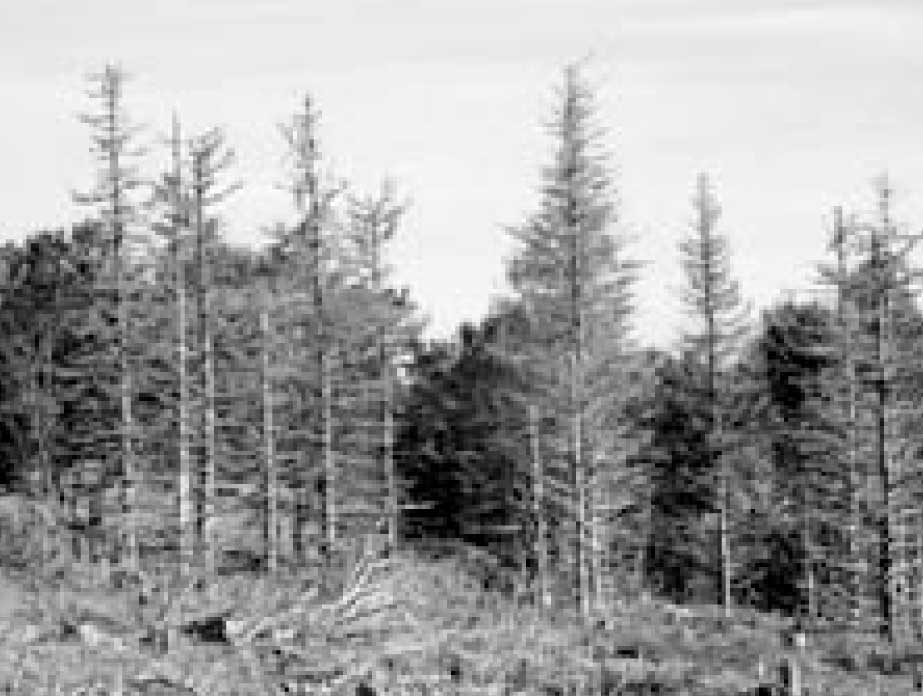 |
|
| Spruce beetle can cause mortality in white spruce trees. |
After speaking with a friend that commended the benefits of belonging to a local woodlot owner organization, Peter decided that this might be a good way to get some solid advice. He phoned a representative of the association, who told them that a woodlot management plan would be the best place to start. The cost of a few hundred dollars seemed like a small price to pay for good guidance.
A Certified Forest Technician met them at the woodlot on their next visit. Francis told them he had written over one hundred management plans for woodlot owners in eastern Nova Scotia. His education and experience were apparent as he easily discussed the options that the Pellys might wish to think about. From the time Francis started talking, the Pellys were convinced they had made the right decision in contacting the woodlot owner association.
Of primary importance in planning, Francis said, were the Pellys’ goals and objectives. If these were realistic, there would likely always be a way forward.
Initially, Peter and Ellen found it difficult to think of long-term goals. Most of their visits to the woodlot were spent getting everything done that needed to be done – like repairing the door sill of the camp, or clearing up the trees that had blown down across the road, or replacing that gravel that always seemed to be running off the road. How could they think long-term, when there was so much that needed to be done?
Francis explained that a management plan would ease the concerns that seemed to be a constant source of anxiety. Having long-term goals, he said, would help prioritize the tasks that needed to be completed in the short-term.
He was right. From the moment they asked Francis to complete a management plan for the woodlot, the Pellys had a sense of purpose and organization.
The Pellys started to think about what would be realistic goals over the next ten years. With Ann-Eve intent on attending university soon, their aim was to generate $5,000 from the woodlot over two years. They also wanted to do what was best to keep the woodlot healthy and productive. Peter wanted to retain his hunting opportunities, while Ellen was always pleased with the firewood they were able to use during their stays at the camp.
As they set off to find the boundary lines, Peter reflected on the fact that he had not maintained the lines in years. Fortunately, they found the four corners after some searching. A sunken barbed wire fence formed two of the lines, and old tree blazes marked the remainder. In some places the wire was below the ground.
As they walked through the woodlot, Francis pointed out many things that had escaped the Pellys’ attention. He discussed the spruce beetle that was slowly killing the spruce in some areas of the old fields. Francis used an instrument called an increment borer to show the Pellys that the growth of the spruce had decreased markedly over the last five years.
Later, using the borer, he took core samples from balsam fir that dotted the lower slopes of the hardwood ridge. Here they could see rot beginning to form near the center of nearly every tree. The Pellys realized that there was more to woodlot management than met the eye.
By harvesting some of the fir and spruce in a timely manner, Francis explained, the productivity of the woodlot would be maintained as natural regeneration became established. Thinning stands as they matured would increase growth and maximize yield. Other, uneven-aged stands could be managed by selection harvesting.
 |
|
| Careful selection harvesting will leave the forest floor intact. |
Peter grinned as they stepped through the hardwood stands on the ridge near the rear of the woodlot. This was a place he always loved to visit, especially in the fall when he could smell the rich fragrance of the earth as the trees surrendered their leaves for the winter. This was an area he’d like to leave alone for now. Maybe his great-grandchildren would experience the same feelings as they walked here. Now that would be something.
With the help of an aerial photo, Francis led them to a sheltered stand of softwood. Here, large hemlocks and Red spruce stood towering over patches of younger trees. Tiny seedlings formed green carpets here and there, and two barred owls – gray as the stones in the graveyard – glided away among the trees.
Here, Francis said, they could remove some of the trees, creating openings in the canopy that would allow sunlight to reach the seedlings. To keep from disturbing the owls that were obviously nesting here, they would leave 100 meter buffers around any nests and complete the forestry work in late summer or early fall.
Back at the camp, Francis indicated that a management plan can be flexible if the woodlot owners change their minds, or if other circumstances change. One of the real values of a plan, he stated, was that it is a document that can be shown to contractors or others, so that there are no misunderstandings about proposed activities.
The management plan was finished two months later. It indicated the Pellys’ goals, and listed objectives that were needed to achieve those goals. Together with an aerial photo and map of the woodlot, the plan had tables of stand descriptions and recommendations. It described the condition of the boundary lines and where a new road should be built. It even had a few pages near the back where the Pellys could track their progress over the next ten years.
When the time came for the plan to be revised in five or ten years, Ann-Eve would have more input. For now, Peter and Ellen – with their goals and objectives established – knew where to start.
They knew that it would be for future generations to decide whether they had done their work well.
 |
|
| Old woodlot roads provide good opportunities for both recreation and future management activities. |
Literature Review
Beattie, M. Thompson, C. and Levine, L. 1993. Working with your Woodland: A Landowner’s Guide. University Press of New England, Lebanon, NH. 279 p.
Brett, Richard M. 1983. A Woodlot Primer. Country Journal Publishing Co., Brattleboro, VT. 134 p.
Fazio, James R. 1987. The Woodland Steward. The Woodland Press, Moscow, ID. 211p.
Hilts, S. and Mitchell, P. 1999. The Woodlot Management Handbook. Firefly Books Ltd., Willowdale, ON. 282 p.
Keys, K., Neily, P. and E. Quigley. 2011. Forest Ecosystem Classification for Nova Scotia, Part 1: Vegetation Types (2010). Report FOR 2011-1. Nova Scotia Department of Natural Resources. 264 p.
Keys, K., Neily, P. and E. Quigley. 2011. Forest Ecosystem Classification for Nova Scotia, Part 2: Soil Types (2010). Report FOR 2011-3. Nova Scotia Department of Natural Resources. 119 p.
Keys, K., Neily, P. and E. Quigley. 2011. Forest Ecosystem Classification for Nova Scotia, Part 3: Ecosites (2010). Report FOR 2011-2. Nova Scotia Department of Natural Resources. 92 p.
Kohar, K.A. and J.F. Franklin (Ed). Creating a Forestry for the 21st Century. Island Press, Washington, DC. 475 p.
McEvoy, Thom J. 2005. Owning and Managing Forests. Island Press, Washington, DC. 300 p.
Nova Forest Alliance. 2007. Contractors and Operators Best Management Practices Manual. Nova Forest Alliance, Stewiacke, NS. 72 p.
Robinson, G. 1988. The Forest and the Trees: A Guide to Excellent Forestry. Island Press, Washington, DC. 257 p.
Downloads
As the Home Study modules become available copies will be made available for download. At this time only the Introduction - Getting More from your Woodlot, Module 2 and 9 are available in French.
| All modules are currently available in English and some in French |
Adobe Acrobat
Acrobate D'Adobe |
| Principles of Forest Stewardship | Download |
| Introduction: Getting More From Your Woodlot |
English Francais |
| Module 1: Introduction to Silviculture | Download |
| Module 2: Harvesting Systems |
English Francais |
| Module 3: Thinning for Value | Download |
| Module 4: Woodlots and Wildlife | Download |
| Module 5: Stand Establishment | Download |
| Module 6: Chainsaw Use and Safety | Download |
| Module 7: Woodlot Ecology | Download |
| Module 8: Wood Utilization and Technology | Download |
| Module 9: Woodlot Recreation |
English Francais |
| Module 10A: Managing Woodlot Finances:Planning and Investment Guide | Download |
| Module 10B: Introduction to Woodlot: Income Tax and Estate Planning | Download |
| Module 11: Roads & Trails: Planning it Right from the Start | Download |
| Module 12: Small Scale Harvesting Equipment | Download |
| Module 13: Non Timber Forest Products: Growing Opportunities | Download |